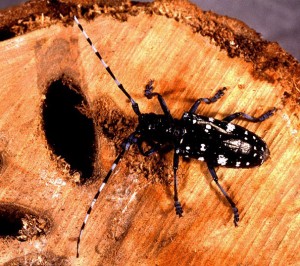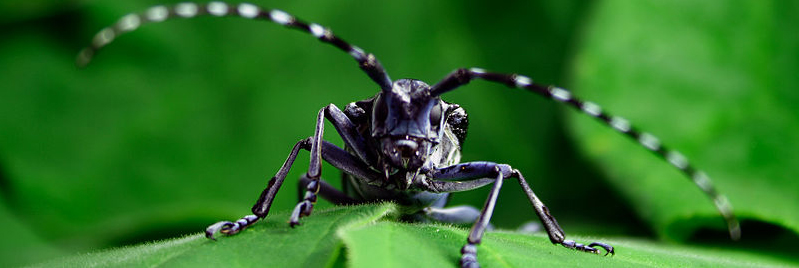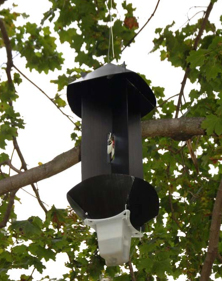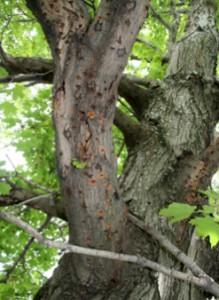NYBG Guards Against a Six-Legged Menace
Posted in Around the Garden, Science on August 1 2012, by Matt Newman
 Asian longhorned beetles (ALB) are many things, but picky eaters isn’t one of them. It’s part of the reason they’re now such persistent pests throughout the northern United States. Worse, they’re approaching something of an outright pestilence. These non-native invaders are mincing maple populations, trashing elms, making a buffet of poplars and will happily bore into a wide menu of other tree genera! But thanks to a partnership with the Sentinel Plant Network, a USDA-funded collaboration between North American public gardens and other concerned groups, the NYBG is proud to serve as one of a number of “watchposts” striving to counter the menace through safe, effective means. That’s where our bug traps come in.
Asian longhorned beetles (ALB) are many things, but picky eaters isn’t one of them. It’s part of the reason they’re now such persistent pests throughout the northern United States. Worse, they’re approaching something of an outright pestilence. These non-native invaders are mincing maple populations, trashing elms, making a buffet of poplars and will happily bore into a wide menu of other tree genera! But thanks to a partnership with the Sentinel Plant Network, a USDA-funded collaboration between North American public gardens and other concerned groups, the NYBG is proud to serve as one of a number of “watchposts” striving to counter the menace through safe, effective means. That’s where our bug traps come in.
Native to Japan, China, and Korea, Anoplophora glabripennis first made its U.S. presence known in 1996. Soon after, it was found in Canada, France, Italy, Germany, and a slew of other countries less than welcoming of their newest guests. By the time authorities concluded that hardwood shipping crates were to blame, it was too late to shut the door: the beetles were already reproducing, boring into trees to lay their eggs. Upon hatching, the larvae then ravage the trees further, feasting on bark and inner wood. And 16 years later, the hunt continues for a fool-proof means of eradicating the ALB from American forests.
I spoke with Don Gabel, the NYBG’s Manager of Plant Health, on the reality of ALB infestations in New York. He was more than willing to offer some insight into the nationwide trap-testing program, and the steps the Garden is taking on its own initiative to ensure these bugs never find a foothold in the Bronx.

“We were invited by the Sentinel Plant Network to help out with this project, alongside a few other arboretums,” Gabel said. “We’re participating as a trial location in the tri-state region. Luckily, the Garden has avoided any infestations so far, and we’re working to keep it that way.
“The program uses pheromone traps, of which we currently have 18 hanging in trees throughout the Garden. China was the first to start testing this method about two years ago, and this year the trap recipe combines five separate attractants: three volatiles of maple, a tree that the beetles prefer to reproduce in, and two types of pheromones from the male insects. Chemically, it’s about as safe and natural as you can get, and it’s aimed at attracting female ALBs looking to mate and lay eggs.”

Having entered the trap, the beetles fall into a saturated solution of salt mixed with a few drops of dish soap–enough to kill the bugs without being toxic to the environment should the trap spill somehow. But the purpose of these traps isn’t necessarily as a bug killer, so much as a bug detector. As in so many cases, early prevention is key.
“Along with our visual inspections, this trapping program will increase our ability to tackle any future problems efficiently,” Gabel continued. “It allows us to catch the problem as early as possible, so we can survey, locate, and map affected trees with GPS, as well as get the word out to gardens in neighboring areas to keep the problem contained.”
So far, so good–there haven’t been any longhorned beetles found in our traps since they were set up in June. In fact, New York state has seen an overall drop-off in beetle encounters over the last ten years. However, Gabel is quick to remind me that the tri-state area still has regions suffering from a saturation of the invading pests, meaning no precaution is ignored.

“It’s a daunting task, but [Garden interns] are out there surveying each and every susceptible tree in the Garden to form a GPS database, to help us work with the USDA in the event we find ALBs. In the New York City area, we’re especially on guard against possible infestations coming from affected regions further north, be it from firewood, plant parts, or natural migration of the insects.”
In the northeast, Massachusetts has been the hardest-hit so far. The town of Worcester is experiencing a “nightmare” scenario: ALBs moving beyond contained areas to invade surrounding forests. But there’s hope that this program, and future developments in the ongoing battle against the beetle, will see us succeed in stamping out this six-legged menace not only here, but across North America.
Keep in mind that public gardens and maple tree farms aren’t the only environments susceptible to these hungry pests–be on the lookout in your own neighborhood! If you happen to see what you suspect might be an ALB infestation, or you’re looking for more information on how to identify these critters, head over to the USDA’s Beetle Busters page. There you’ll find pictures, tips, and a place to report any sighting, helping to ensure the survival of our iconic hardwoods for future generations.
And remember: never, ever transport firewood. Always burn it in the same area that it was purchased to prevent the spread of these hungry invaders.
Asian longhorned beetle photos courtesy of Wikimedia Commons.
Trap and damage photos courtesy of the USDA.

